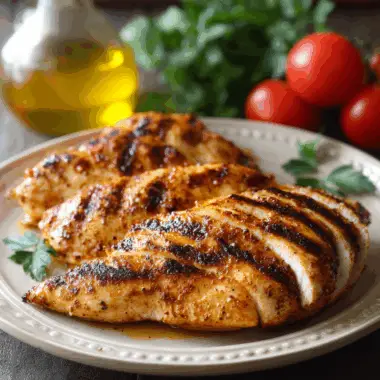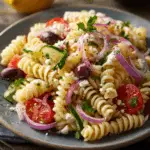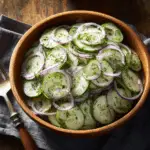This Greek Pasta Salad is a vibrant and refreshing twist on the classic side dish. With crisp cucumbers, juicy cherry tomatoes, briny Kalamata olives, and tangy feta all tossed in a lemony garlic dressing, it’s like a Greek vacation in every bite. The pasta soaks up all the zesty goodness, making this dish ideal for packing up for outdoor gatherings or enjoying straight from the fridge on a hot day.
Beyond its great taste and beautiful presentation, this salad is flexible and easy to make. Whether you’re using gluten-free pasta, lentil-based rotini, or traditional varieties, the bold Mediterranean flavors shine through. The homemade dressing is a winner on its own — great not just here, but also on grilled veggies or seafood. This dish is truly a staple for summer and beyond.
Full Recipe:
For the Dressing:
-
1/3 cup freshly squeezed lemon juice (from 2 to 3 lemons)
-
1 tablespoon lemon zest
-
2 cloves garlic, finely chopped
-
2 tablespoons finely chopped parsley
-
1/2 cup extra virgin olive oil
-
1/2 teaspoon fresh oregano (optional)
-
1/4 teaspoon salt
-
1/4 teaspoon pepper
For the Salad:
-
1 pound rotini pasta (or any preferred pasta shape)
-
1/2 small red onion, thinly sliced
-
1 red bell pepper, finely diced
-
1 pint cherry tomatoes, halved
-
1/2 cup pitted Kalamata olives
-
1/2 cup crumbled feta cheese
-
1 large cucumber, quartered and sliced
-
1/4 cup fresh parsley, roughly chopped
-
Salt and pepper, to taste
Directions:
-
Bring a large pot of salted water to a boil. Add pasta and cook until al dente. Drain and rinse with cold water until cool.
-
Soak sliced red onions in a bowl of cold water with a pinch of salt for 10 minutes. Drain well.
-
In a jar with a tight-fitting lid, combine lemon juice, zest, garlic, parsley, olive oil, oregano (if using), salt, and pepper. Shake well until emulsified.
-
In a large bowl, combine the cooled pasta, soaked onions, red bell pepper, cherry tomatoes, olives, feta, cucumber, and parsley.
-
Drizzle with 1/4 cup of the dressing and toss gently. Add more dressing to taste.
-
Season with additional salt and pepper if needed. Serve immediately or refrigerate until ready to enjoy.
Prep Time: 20 minutes | Cooking Time: 10 minutes | Total Time: 30 minutes
Kcal: 310 kcal per serving | Servings: 6 servings
A Flavorful Journey Through Greek Pasta Salad
Greek Pasta Salad is more than just a dish — it’s a delightful representation of Mediterranean culinary culture, combining bright vegetables, zesty flavors, and satisfying textures into one harmonious bowl. Whether you’re preparing for a casual summer lunch, a picnic in the park, or a family potluck, this recipe offers a refreshingly light yet filling option that never fails to please. At its heart, this salad takes the bold flavors of a traditional Greek salad and enhances them with the heartiness of pasta, creating a dish that’s both comforting and crisp.
The Origins of the Dish
Traditional Greek salad, known as “Horiatiki,” is a rustic and colorful mix of ripe tomatoes, cucumbers, onions, olives, and feta cheese, typically dressed with olive oil and herbs. The Greek Pasta Salad builds upon this tradition, incorporating cooked pasta to turn a side salad into a main-course contender. By doing so, it combines the centuries-old heritage of Greek flavors with the versatility and global popularity of pasta.
This dish may not have deep historical roots in traditional Greek cuisine per se, but it is a clever, modern fusion that respects the core elements of Mediterranean cooking. It’s a perfect example of how simple, fresh ingredients can be elevated with thoughtful preparation and creative presentation.
The Mediterranean Diet and Its Health Benefits
One of the most compelling reasons for the rising popularity of Greek Pasta Salad is its alignment with the Mediterranean diet, widely considered one of the healthiest in the world. Rich in vegetables, whole grains, healthy fats, and moderate in dairy and lean proteins, this way of eating promotes heart health, weight management, and even cognitive longevity.
Greek Pasta Salad fits seamlessly into this dietary philosophy. It features a balance of fiber-rich vegetables, antioxidant-laden olives, calcium-packed feta cheese, and heart-healthy olive oil. When prepared with whole-grain or gluten-free pasta, it also caters to those following specialized diets without sacrificing taste or satisfaction.
Why This Recipe Works
What makes this Greek Pasta Salad stand out is its well-rounded profile of flavors and textures. You get the sweetness and juiciness of cherry tomatoes, the cooling crunch of cucumbers, the briny bite of Kalamata olives, and the creamy tang of feta cheese. Each bite is a medley of contrast — crisp yet tender, salty yet fresh, and vibrant yet comforting.
The dressing is another highlight. Made with fresh lemon juice, zest, garlic, and olive oil, it’s a zippy, refreshing vinaigrette that brightens every ingredient it touches. Unlike heavier mayonnaise-based dressings, this lemon-olive oil combo enhances the salad without overwhelming it. It also acts as a natural preservative, helping the salad stay fresh longer — a key advantage for meal prep and make-ahead plans.
Additionally, soaking the red onions briefly in salted cold water is a smart trick used by chefs to tame their sharpness. This ensures that the onions maintain their crunch and flavor without overpowering the other ingredients. Small techniques like this elevate the dish from ordinary to exceptional.
Customization and Variations
One of the best things about Greek Pasta Salad is its adaptability. This dish is like a blank canvas, welcoming creativity and dietary preferences with open arms. For example:
-
Protein Additions: You can add grilled chicken, shrimp, or chickpeas to turn it into a protein-packed meal.
-
Pasta Choices: From traditional rotini to lentil or chickpea-based pasta, the recipe is easily adaptable to gluten-free or higher-protein diets.
-
Vegetable Swaps: Zucchini, artichoke hearts, or spinach can be added or swapped in depending on seasonality or personal taste.
-
Cheese Alternatives: If you’re avoiding dairy, consider vegan feta or nutritional yeast to mimic the tanginess of cheese.
-
Herb Enhancements: Fresh mint or dill can be used in place of or alongside parsley for a different flavor profile.
These customizations ensure that the dish never feels repetitive and can be enjoyed across seasons and occasions.
Serving and Storage Tips
Greek Pasta Salad is ideal for gatherings because it tastes best when made a few hours ahead of time. The resting period allows the flavors to meld, and the dressing to fully coat the ingredients. It holds up exceptionally well in the fridge, maintaining its texture and flavor for up to three days when stored in an airtight container.
When serving, bring it to room temperature for the best flavor. If the pasta seems a little dry after refrigeration, simply toss it with a small splash of olive oil or a spoonful of reserved dressing to revive its freshness.
This salad is also travel-friendly, making it a favorite for potlucks, beach outings, or office lunches. Since it doesn’t contain mayo or other highly perishable ingredients, it’s a safer choice for warm weather and outdoor events.
Pairing Ideas
Pairing this dish with the right accompaniments can turn a simple salad into a complete Mediterranean feast. Consider serving it alongside:
-
Grilled chicken souvlaki or lamb skewers
-
Warm pita bread and hummus
-
Stuffed grape leaves (dolmades)
-
Tzatziki dip with sliced vegetables
-
A chilled glass of dry white wine like Assyrtiko or Sauvignon Blanc
Together, these pairings create a well-rounded meal that is both festive and nourishing.
Cultural Appreciation Without Appropriation
While Greek Pasta Salad may not be an ancient dish, it is rooted in a deep appreciation for the culinary traditions of Greece. Understanding the flavors and techniques that define Mediterranean cooking—such as the liberal use of olive oil, the importance of fresh herbs, and the emphasis on simplicity—helps ensure that this modern recipe pays respectful homage to its inspirations.
It’s important to recognize that culinary fusion is a product of global exchange, and that cooking in this style can foster appreciation and curiosity for different food cultures when done thoughtfully and respectfully.
Perfect for All Occasions
Whether you’re meal prepping for the week or planning a weekend barbecue, Greek Pasta Salad has you covered. It strikes the perfect balance between indulgence and health, making it suitable for everyday meals as well as special occasions. It’s also kid-friendly and easy to scale, whether you’re feeding a family of four or a crowd of forty.
With the ability to be served chilled or at room temperature, it offers unmatched flexibility. Plus, it’s vegetarian-friendly and easily customizable for vegan, gluten-free, or dairy-free diets, which means it appeals to a wide range of dietary needs.
Conclusion
Greek Pasta Salad is not just a side dish — it’s an invitation to experience the beauty and simplicity of Mediterranean flavors. Combining the beloved elements of Greek salad with the satisfying texture of pasta, this recipe embodies freshness, health, and flexibility. It’s a dish that’s as vibrant in taste as it is in color, and one that belongs in every cook’s seasonal repertoire.
Whether you’re introducing it to your weeknight dinners or showcasing it at summer celebrations, this salad will undoubtedly earn its place as a go-to favorite. With endless ways to customize and pair it, Greek Pasta Salad is the gift that keeps on giving — simple, soulful, and incredibly satisfying.








